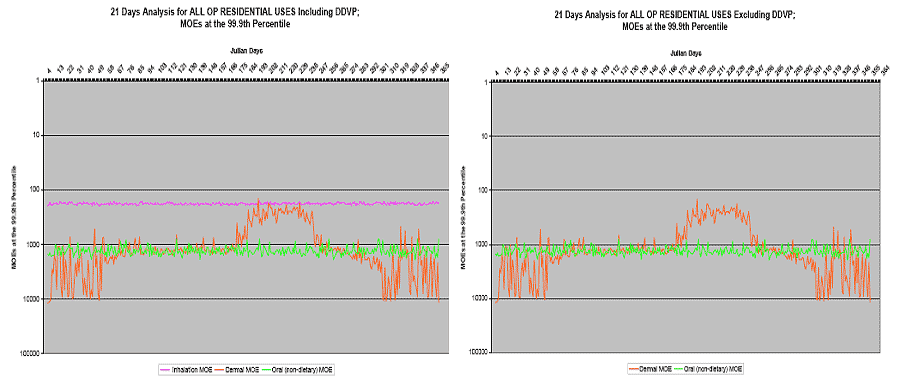Appendix H - Interpreting Tables and Graphs, 3
Excerpt (with clarification added) from EPA's "Organophosphorus Cumulative Risk Assessment - 2006 Update, p. 98-100.
The results for children 1-2 years old indicate that incidental oral MOEs are not of concern. Additionally, dermal MOEs are well above the level of concern (above 1000) for most of the year. However, a portion of the summer months (days 186 through 243), MOEs go down to approximately 150. Further analysis has determined that these MOEs are the result of trichlorfon lawn exposure. This decrease in MOEs is attributed to the application pattern information for the trichlorfon lawn scenarios. Lawn applications of trichlorfon are expected to occur in the summer months to treat lawn pests, such as grubs, webworms, billbugs, mole crickets and chinch bugs. The inhalation MOEs are consistently the lowest and therefore present the greatest risk. By removing DDVP from the residential assessment, OPP (EPA's Office of Pesticide Programs) determined that the inhalation MOEs result entirely from exposure from the DDVP indoor uses. This is illustrated in the figures below: when all DDVP use is removed from the assessment, no inhalation risks are apparent. Residential inhalation exposure primarily results from indoor post-application exposure to DDVP pest strip and pet collars. Indoor exposure to DDVP pest strips and pet collars is continuous for the effective life of the product (up to 16 weeks). DDVP pest strips and pet collars are constantly emitting sources that dissipate over the duration of use. 20

- Why is there no Inhalation line on the second graph?
- What is the reason that the dermal MOE decreases (look at scales carefully) around day 175?

Comments: